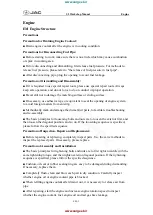
R
When driving down an incline, make use of
the engine's braking effect. Observe the
engine speed; do not overrev the engine.
R
Before driving on extreme uphill and down-
hill gradients, select the LOW RANGE off-
road gear (
Y
page 253).
R
Drive slowly.
R
Avoid high engine speeds. Drive at appro-
priate engine speeds (maximum
3,000 rpm).
R
Use the left-hand paddle shifter to shift into
a lower gear in good time on long and steep
downhill gradients.
R
Check the brakes after prolonged off-road
driving.
i
Hill start assist will aid you when pulling
away on a hill.
For further information about hill start
assist, see (
Y
page 161).
Do not switch to transmission position N
when driving off-road. If you try to brake the
vehicle using the service brake, you could
lose control of the vehicle. If the gradient is
too steep for your vehicle, drive back down in
reverse gear.
Always observe the approach/departure
angle values (
Y
page 458).
Maximum gradient-climbing capability
Always observe the maximum gradient climb-
ing ability values (
Y
page 458).
Hilltops
When driving up an uphill gradient, slightly
reduce pressure on the accelerator immedi-
ately before reaching the brow of the hill. Use
the vehicle's own impetus to drive over the
top of the hill.
This style of driving prevents:
R
the vehicle from lifting off the ground on the
brow of a hill
R
the vehicle from traveling too quickly down
the other side
Driving downhill
R
Drive slowly.
R
Do not drive at an angle down steep
inclines. Steer into the line of fall and drive
with the front wheels aligned straight. Oth-
erwise, the vehicle could slip sideways, tip
and rollover.
R
Shift to a lower gear using the left-hand
paddle shifter before tackling steep down-
hill gradients.
R
Activate DSR. If this is not sufficient, brake
gently. When doing so, make sure that the
vehicle is facing in the direction of the line
of fall.
R
Check that the brakes are working normally
after a long downhill stretch.
i
The special off-road ABS setting enables a
precise, brief and repeated locking of the
front wheels. This causes them to dig into
loose earth. Be aware that the front wheels
easily skid across the ground surface if
completely braked and therefore lose their
ability to steer.
Driving systems
Cruise control
General notes
Cruise control maintains a constant road
speed for you. It brakes automatically in order
to avoid exceeding the set speed. You must
select a lower gear in good time on long and
steep downhill gradients, especially if the
vehicle is laden or towing a trailer. By doing
so, you will make use of the braking effect of
the engine. This relieves the load on the brake
system and prevents the brakes from over-
heating and wearing too quickly.
Use cruise control only if road and traffic con-
ditions make it appropriate to maintain a
steady speed for a prolonged period. You can
store any road speed above 20 mph
(30 km/h).
Driving systems
195
Driving
and
parking
Z
Summary of Contents for 2001 M-Class
Page 4: ......
Page 34: ...32...
Page 104: ...102...
Page 120: ...118...
Page 156: ...154...
Page 266: ...264...
Page 334: ...332...
Page 335: ...Useful information 334 Stowage areas 334 Features 345 333 Stowage and features...
Page 382: ...380...
Page 446: ...444...
Page 464: ...462...
Page 465: ...463...
Page 466: ...464...
















































